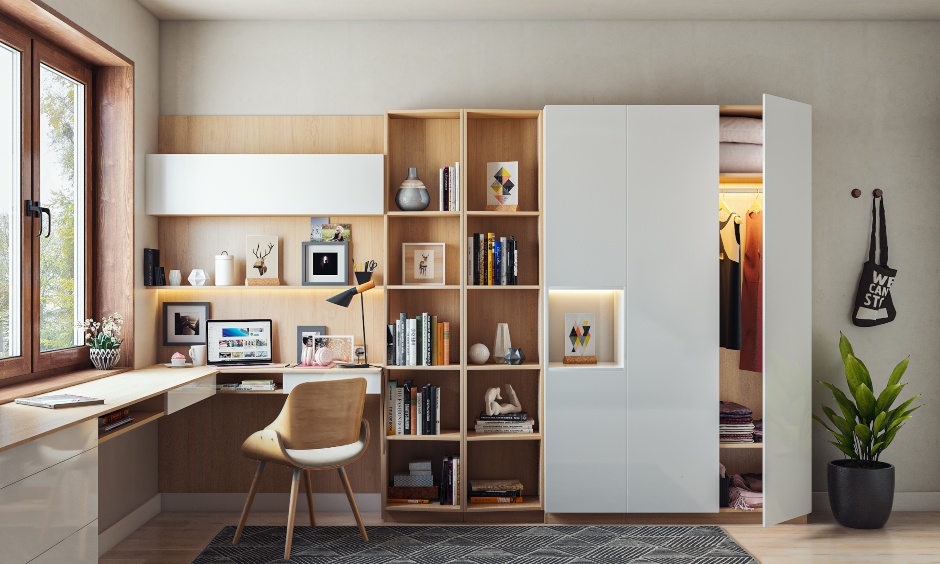Home Office Interior Design

Anúncios
The concept of working from home has become very popular in recent years, leading to a greater emphasis on creating functional and aesthetically pleasing home office spaces. Home office interior design plays a vital role in increasing productivity, promoting concentration and providing a conducive environment for remote working. In this article, we’ll explore some innovative and practical home office interior design ideas to help professionals create the perfect workspace from home.
1. Choose the Right Location
Choosing the right location for your home office is critical to a successful workspace. Consider a place with lots of natural light, as this can significantly affect mood and productivity. A well-lit environment reduces eye strain, making it easier to stay focused and motivated throughout the day.
Anúncios
2. Ergonomic Furniture
Investing in ergonomic furniture is a must for any home office. Comfortable and supportive chairs and adjustable desks can promote better posture and prevent health problems associated with prolonged sitting. Ergonomic furniture not only increases productivity but also contributes to an individual’s overall well-being.
3. Tidy up and Organize
A cluttered workspace can be distracting. That is why it is crucial to tidy up your office space regularly and efficiently. Keep essentials within reach and keep your environment clean and tidy with storage solutions such as shelves, cabinets and drawers.
Anúncios
4. Personalization and Inspiration
Add a personal touch to your home office by incorporating elements that inspire and motivate you. Create a positive atmosphere by decorating the room with artwork, inspiring quotes or plants. Personalization can make a workspace warm and inviting, boosting creativity and productivity.
5. Technology and Connectivity
A well-equipped home office requires reliable technology and seamless connectivity. Provide fast internet, a fully functional computer or laptop and all necessary peripherals such as printers and scanners. Keeping up with the latest technology increases efficiency and streamlines workflow.
6. Sound Insulation
If your home office is in a busy area or has noisy neighbors, consider soundproofing the room. Unwanted noise can be a very disturbing and targeted nuisance. Soundproofing measures may include the use of thick curtains, carpets or acoustic panels to create a calmer and more focused environment.
7. Green Elements
Incorporating green elements such as houseplants into your home office can have a major impact on your health. Plants not only purify the air, but also add a touch of nature to your environment, promote a sense of tranquility and reduce stress.
8. Good Lighting
Make sure your home office has plenty of artificial light in addition to natural light. A well-lit workspace prevents eye strain and keeps you focused late at night or on cloudy days. Consider using task lighting in specific work areas to maximize productivity.
9. Flexibility and Versatility
Design your home office with flexibility and versatility in mind. Create a space that can adapt to different work requirements and even serve as a relaxation area. The flexible design allows for better use of space, allowing the office to meet different needs.
10. Color Psychology
The choice of color for your home office can affect your mood and energy level. Choose colors that help you focus, such as blue or green. Avoid colors that are too bright or distracting as this can affect your ability to work efficiently.
Conclusion
In short, the interior design of a home office plays a vital role in creating a conducive and efficient working environment. By carefully considering factors such as location, furniture, organisation, personalization and technology, professionals can design their ideal home office space. A well-designed home office can not only increase productivity but also improve overall well-being and job satisfaction, making it a worthwhile investment for home workers.
Frequently Asked Questions
1. Why is the interior of a home office important?
The interior design of a home office is critical as it directly affects productivity, concentration and overall well-being. A well-designed workspace can increase the motivation, creativity and job satisfaction of remote workers, increasing their productivity and success in their careers.
2. How do I choose the right location for my home office?
When choosing a location for your home office, consider an area with plenty of natural light, minimal distractions, and a comfortable atmosphere. Ideally, choose an area with windows where you can enjoy natural light, which can positively impact mood and reduce eye strain during work hours.
3. What is the meaning of ergonomic furniture in a home office?
Ergonomic furniture, such as reclining chairs and tables, is essential for maintaining good posture and avoiding discomfort during long hours of work. Investing in ergonomic furniture can promote health, reduce the risk of musculoskeletal problems and contribute to overall well-being.
4. How do I keep my home office organized and tidy?
To maintain an organized home office, take advantage of storage solutions such as shelves, cabinets and drawers. Regularly organize your workspace and keep only the essentials within reach. A tidy environment minimizes distractions, increasing focus and productivity.
5. What are some ideas for personalizing my home office?
Personalization can include decorating your home office with artwork, inspirational quotes, family photos, and even houseplants. By adding elements that inspire you, you can create a positive and inviting atmosphere that promotes creativity and motivation.
6. How do you ensure seamless technology and connectivity in your home office?
Invest in reliable technology such as high-speed internet, a fully functional computer or laptop, and necessary peripherals such as printers and scanners to ensure a smooth workflow. Keeping up to date with the latest technology can increase productivity and efficiency.